What does every American want to see during a vacation to Germany? Neuschwanstein, Oktoberfest, Hofbrauhaus, Linderhof. These are the most famous places in Germany, at least to most Americans. How many of these places have I seen since moving here? 1. Hofbrauhaus. In 7 years I have yet to see the “real” Germany. With COVID-19 restricting our travel plans, Kathrin suggested a vacation in Bavaria, “To finally check the American sights off the list.” Don’t underestimate the sacrifice this means for her. Conservative, catholic Bavaria is enemy territory. She would rather stick needles in her eyes than drive a BMW, watch a Bayern-München soccer game, or wear a Dirndl. She will set her prejudices aside once, just once, so I can experience the American vacation experience here in Germany.
Once she committed to this, she went all in. We planned a 2 week trip filled to the brim with all the sights worth seeing, and some sights that aren’t even on the American list.
Our schedule included celebrating our anniversary and my birthday in Munich. Munich, the heart and soul of Bavaria! This is sacrifice, this is genuine love. Kathrin wasn’t just turning lemons into lemonade, she was spiking it with rum.
In the end we planned a round trip starting in Munich. From there we would stop in Schwangau for the castles. We would proceed to Garmisch-Partenkirchen and Chiemsee mostly for the nature and outdoor attractions. Then on to Berchtesgaden to see Hitler’s creation. Continue on to Königsee for more nature, and Bad Reichhall to see a salt mine. Our final stop would be Dachau, then back home.
One thing we decided not to do was pre-book hotels – other than Munich. We wanted the flexibility to stay in each location as long as we wanted. Traveling this way was a bit out of our comfort zone, but we were confident that it would work out.
Finally, the day of our vacation has arrived! We woke up, enjoyed breakfast, packed the car, and set off. According to Google maps, the drive down would take 4 hours.
After a 5.5 hour drive, we arrived in Munich at our hotel, Marc München, about 3:30pm. We ran into two delays because of accidents –
Once we delivered our suitcases up to our room and settled in, we started our hunt for a spot to park the car. The hotel charges 12 Euros/day for parking. That’s 36 Euros for the 3 nights of our stay. Hmmm, 36 Euros can buy a lot of beer here. Since we brought our folding bikes with us, we saved the money and found a quiet road 10 minutes away to park for the weekend.
With that out of the way, we began an initial exploration of Munich. Our plan was to do a bit of geocaching and get a first impression of the town. Within about 5 minutes, Kathrin asked me if I had the bike lock. Of course not. So I left her at an intersection and I went back for the lock. Once I was back, I couldn’t find her. After searching around for a few minutes, I called her. We had the typical exchange, “Where are you?”
“I’m here, where are you?”
“You can’t be here, because I’m here and I don’t see you.”
Turns out we were on opposite corners of the same intersection. Kathrin gave up on the geocache she was about to find and came to my side. After a grumpy ride to the next intersection, we realized we were hungry. With this new information, we changed plans and decided to have an early dinner.
The Löwenbräukeller stood just down the block and looked inviting. What better place to have our introductory Munich meal than a Biergarten! Kathrin ordered Leberkäse (meatloaf) – with a fried egg on top and fried potatoes. I chose Schweinshaxe – pork knuckle – it doesn’t get any more German than that. We washed it all down with two Löwenbräu dark beers.
With full bellies, we got back on our bikes and wandered around town in search of a few geocaches. Our route to our first stop brought us to Königsplatz. It is a well-known place for its neoclassical buildings, including the Glyptothek (a sculpture gallery which is temporarily closed.) and an Antiques museum. But what grabbed our attention was the small carnival taking place here. Almost immediately upon our arrival, Kathrin suggested that I have dessert. One whiff and I knew what she meant. “Burned almonds” are a staple at German carnivals, a yummy treat of roasted, cinnamon and sugar-coated almonds that I couldn’t say no to.
As we wandered through this part of the city, admiring the sights, we admitted to each other that Munich’s old world, regal architecture and lack of skyscrapers make a good impression. We were constantly pointing, ohhh’ing and ahhh’ing.
Our last stop of the day was at Neptune’s fountain at the Old Botanical Garden. We stopped here to find a cache, so we didn’t look around the park, but the fountain is worth a photo stop, even without a cache. In 1914 the city built a new, larger botanical garden and downgraded this one to a park.
About 7pm we were back in the hotel. We agreed that we made an excellent choice. Our room was very spacious, modern looking, cozy, it even had air conditioning, although we didn’t need it this time of year.
Anniversary Day
Our anniversary and our first full day in Munich. We had a very enjoyable buffet breakfast. In coronavirus times this may be a point of concern, but the hotel managed it well. Masks are required, and guests have to use a new set of plastic gloves each time we re-entered the buffet area. As much as we appreciated the hygienical aspect of this, we had a bit of an issue with the environmental impact, so we tried to think of everything to avoid plastic trash. The woman working in the restaurant was diligent, always keeping an eye on the guests and seeing what she could do for us.
The agenda for today included a city-tour geocache. We find these a good way to get to know a place. It’s like having a private tour guide. We began at Marienplatz, the heart of the historical city center and the location of their famous New City Hall.
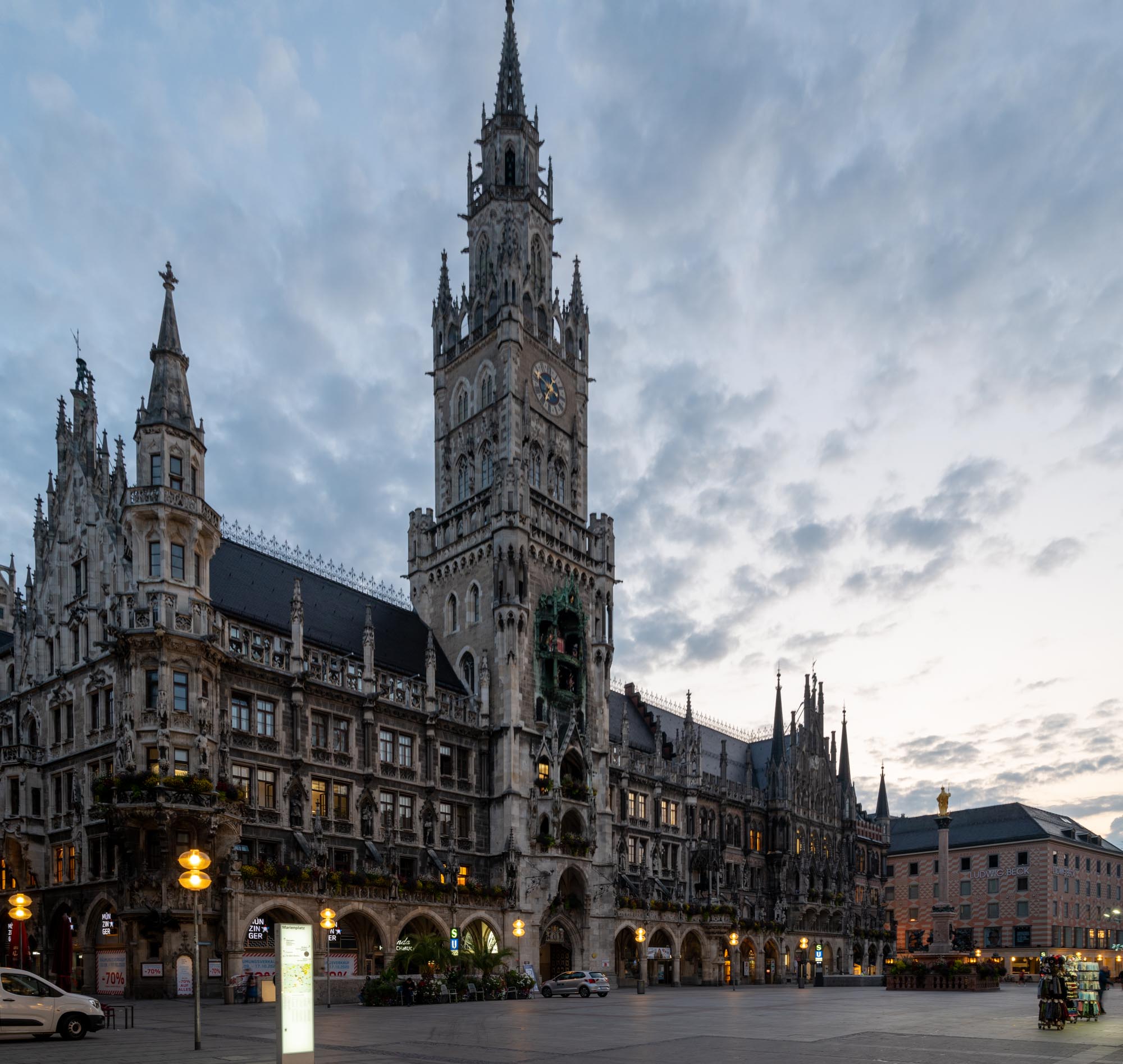
Besides the city hall itself, one of the major draws to this place is the Rathaus-Glockenspiel, a theatrical clock show comprising 43 bells and 32 life-sized figures. The show performs three times a day, 11 am, 12 and 5 pm, and reenacts two stories from the 16th century. The upper half tells the story of the marriage of the local Duke Wilhelm V (founder of the Hofbräuhaus) to Renata of Lorraine. In honor of the happy couple, there is a joust with life-sized knights on horseback. The lower half is the coopers’ dance. In 1517 the plague hit Munich. Legend has it that the coopers danced through the streets to raise peoples’ spirits during these fearful times. Soon after, the plague left Munich. The people gave credit to the coopers and since then, every seven years they dance through the streets. The last dance took place last year, 2019.
Moving on, we came to the Frauenkirche, a double-spired gothic church known for its legendary “Devil’s footprint”.
As we were walking around the building in search for the answer to the question posed by the geocache, we recognized that two restaurants opposite the church were set up for some kind of event. A traditional Bavarian brass band was warming up, and sitting prominently on a high table was a beer keg. The restaurants’ guests, as well as people standing around the area, wore Lederhosen or Dirndls. Then Kathrin started adding up the clues. Yesterday at the Löwenbräu beer garden she saw a sign for “Die Wies’n” which is the local name for Oktoberfest. Today we are in front of a restaurant with a beer keg surrounded by Bavarian dressed locals and an Oompah band. It can only mean one thing – the grand opening of Oktoberfest! Of course the city sponsored event that draws millions of visitors was cancelled because of coronavirus. And we knew that coming here. But that didn’t prevent the restaurants from holding their own celebrations. Soon after the clock struck 12, an official-looking man approached the keg (or “fass” as they call it in german) and, with the appropriate amount of pomp and circumstance, tapped the keg and began filling glasses as the spectators cheered. The tapping ceremony was followed up by festive music from the band.
You might think, “how could you have not known it was opening day of Oktoberfest? It is an annual event!” Yes, Oktoberfest is a yearly event that starts somewhere within the last two weeks of September. However, the official rule states that the festival ends on the first Sunday in October and lasts for 16 days. Therefore, the start date varies.
I spotted something interesting as well. The name of the restaurant hosting this event is “Andechser am Dom”. Andechs is my favorite german beer. Upon hearing this, Kathrin remembered that the Andechs Monastery is not too far from Munich. It turns out that the monastery will be on the way to our next destination, Füssen, so we added it to our itinerary.
The cache tour brought us to an unusual place: the Michael Jackson Memorial. When the King of Pop died in 2009, his fans in Munich set up a makeshift memorial at the base of a statue honoring the Renaissance composer Orlande de Lassus. It has since become a pilgrimage site for MJ fans. Some residents have tried to sabotage it, but diehard groupies return to repair and maintain it. The site was chosen not because of the statue, but because Michael Jackson stayed at the posh five-star hotel Bayerisches Hof, which is across the street.
The English Garden is Munich’s largest park, and our next stop. A British chap by the name of Benjamin Thompson, who worked for the Bavarian Army, designed it. He gave it the name English Garden because he laid it out in the style of an English country park. Riding through the area, we stopped at the Chinese Tower, built in 1789, and again at the Monopterus, a temple on a hill that provides a great view over the area.
However, the most surprising spot, to me, is the Surfer’s Wave. It is an artificial wave built in a man-made river, the “Eisbach” and attracts surfers from around the world. There’s always a crowd of spectators and a line of surfers checking out the show.
We cut the tour short for a much more important event, our anniversary dinner. I had searched TripAdvisor for romantic restaurants in Munich and chose the Ratskeller Restaurant in the basement of the New City Hall. I envisioned a cozy, candle-lit table for a romantic dinner and I wasn’t disappointed. Our table, though not in a corner, was surrounded on 3 sides with high partitions which provided the perfect, private spot for our celebration. The restaurant offered quite a few Oktoberfest selections which we couldn’t resist. The tasty food and attentive staff all came together to make for an unforgettable evening.
My Birthday
Breakfast today was a wonderful as yesterday, the hostess (apparently with a hint from Kathrin) wished me a happy birthday. For my special day we toured the BMW Welt, a showcase of the manufacture’s models and technology. One may also pick up one’s brand new car here and drive off with it. I’m not in the market for a BMW, so I passed on that. I was most interested in the displays presenting BMW’s research in hydrogen fuel cell cars and electric cars. BMW is amongst a small handful of automakers that are pursuing hydrogen fuel cell vehicles, and their exhibit painted an exciting vision of the future. In another area, they showcased their high tech ideas for car sharing. Their existing service, called Share Now (a joint venture with Daimler AG) will include electric, self driving models. Just call a car up via the app and wait for it to arrive. Until that day comes, you will have to walk to the car yourself. You can choose from various Smart, Mercedes-Benz, BMW and Mini models.
BMW World and museum are next to the Olympic park, the site of the 1972 Summer Games. I liked the design of the facilities. The acrylic glass construction had the flowing lines of a large canvas tent. We rode to the summit of Olympiaberg, the high point of the recreational park, to find a geocache. Kathrin had it easy, since she has electrified her Brompton. I had only muscle power to go up the hill. These are the times that I appreciate my time in the gym! Once at the top we knew where to find the cache. The Bavarian authorities set a geodetic reference point on top of the hill. It’s a stone pedestal inscribed with an exact geocoordinate. The cache is in a locked box in the pedestal. I’m not sure how the cache owner got permission to hide it there, but kudos to him. With that done, Kathrin pointed out a group of people with homemade signs wishing someone a happy birthday. As I stood next to it Kathrin quietly took my picture.
We spent the rest of the day completing the geocache sightseeing tour. One of the places we went to was the New Synagogue, Ohel Jakob “Jacob’s Tent”. The base of the building is built with a limestone that looks like the Western Wall in Old Jerusalem. On top sits a glass cube. The glass roof represents a tent, symbolizing Moses’ 40-year journey through the desert.
Another stop brought us to the Asam Church, one of the most famous buildings in the German baroque style. The Asam brothers, Cosmas, a painter, and Egid, a sculptor, built it in the mid-18th century as their private church. Judging by the over-the-top opulence inside, they must have been successful artists. Later, at the behest of Munich’s citizens, the church was opened to the public.
Up to the early 19th century, the farmer’s market was in Marienplatz. At that point, however, the size of the market began to burst at the seams; so, in 1807, King Max I Joseph commanded that the area to the south be used to sell produce. Thus was Viktualienmarkt born, the most well known food market in Munich. It has grown from its humble beginnings as a farmers’ market to a hot spot catering to gourmets. We weren’t here to try any delicasies, we had to find a particular fountain to answer a question posed by our geocache. Later we learned that the people of Munich have built a series of fountains featuring statues to commemorate some of Munich’s famous folk singers and comedians.
Continuing on the tour, we next came to the Deutsches Museum. We only stopped at the courtyard to answer a question of the geocache. Kathrin told me that this is a very worthwhile museum and we should come back one day for a visit. However we should plan a full day to see everything and come on a day when the weather is conducive to indoor activities. On a sunny day like today we prefer being outside.
The river Isar is the lifeline of the city and turns into the city’s beach in summer. Right next to the Isar lies the Müllersches Volksbad, the oldest public swimming pool in the city. At the time of its construction in 1901, it was the largest and most expensive in the world. The Art nouveau architecture gives it an old world look. Had we been better prepared, I would have ventured in. Perhaps on another visit.
As the afternoon drew to an end, we headed back to our hotel to prepare for dinner. I had made a reservation at an Italian restaurant called L’Osteria. It turned out to be an outstanding choice for my birthday. The eclectic collection of decorations, wall paintings, and several chandeliers gave me the feeling of being in a Venetian Hall. The delicious food, the charming ambiance, and the abundance of wine made for a delightful evening.
The next morning, we said goodbye to Munich.
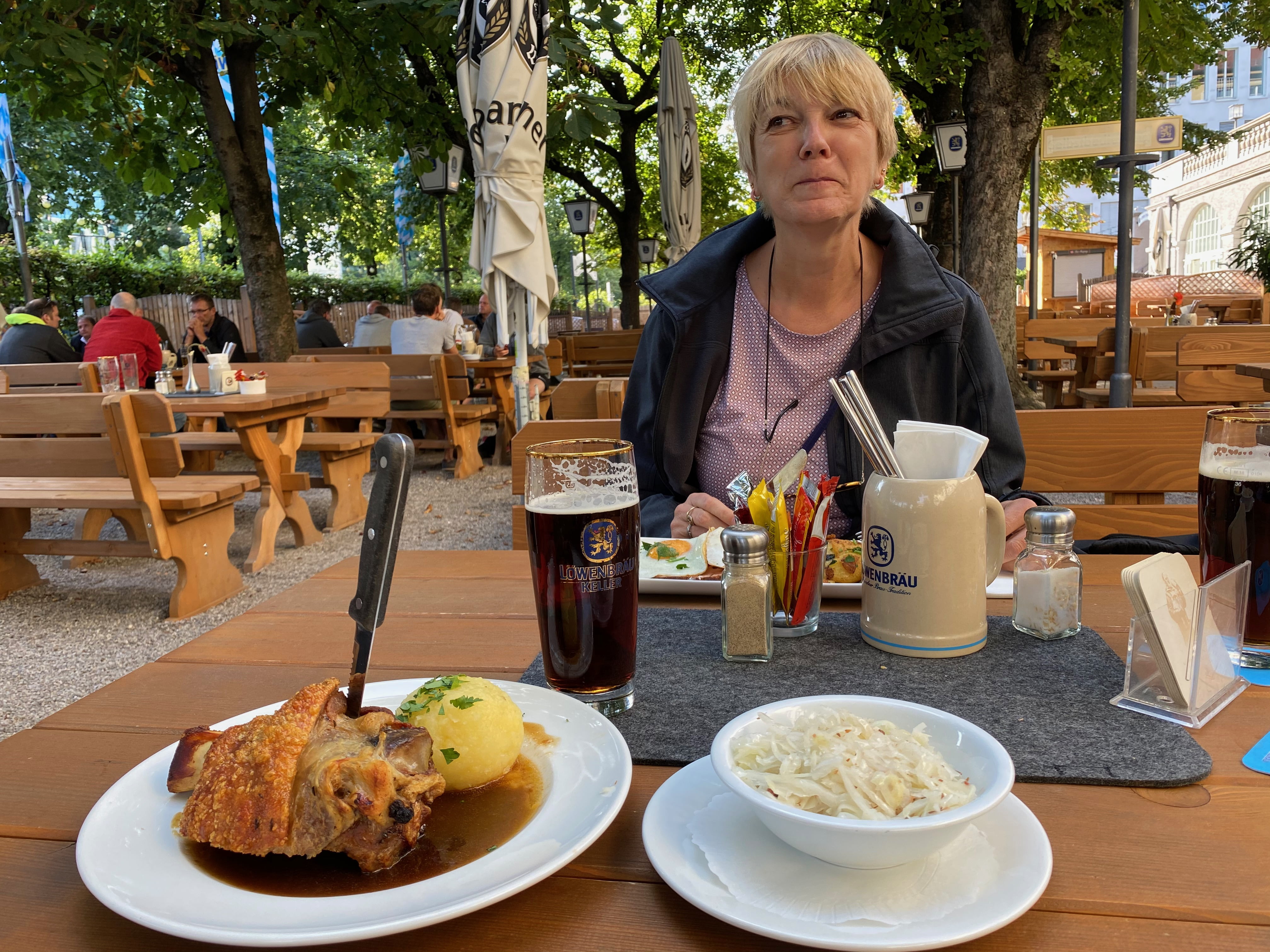



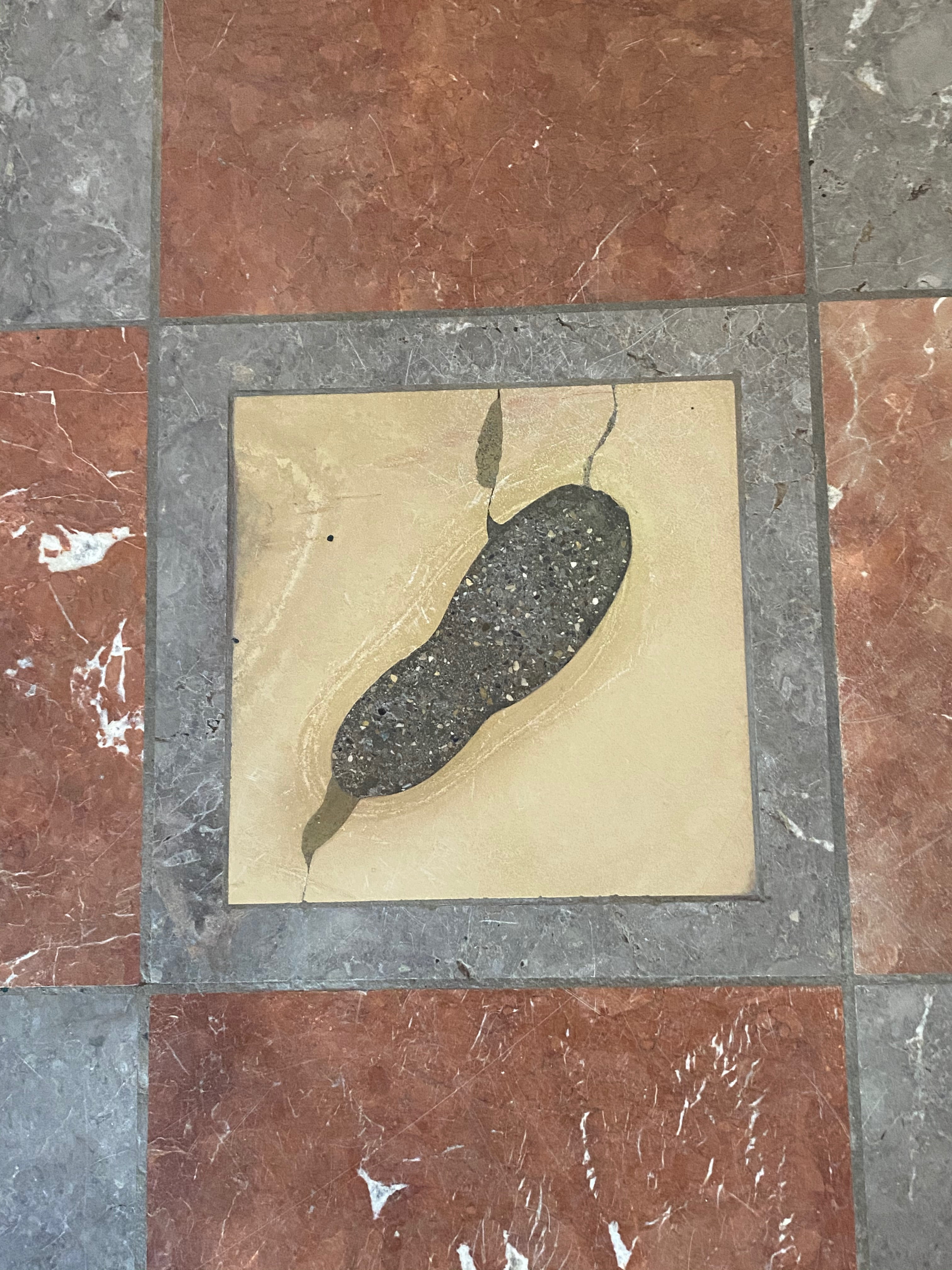



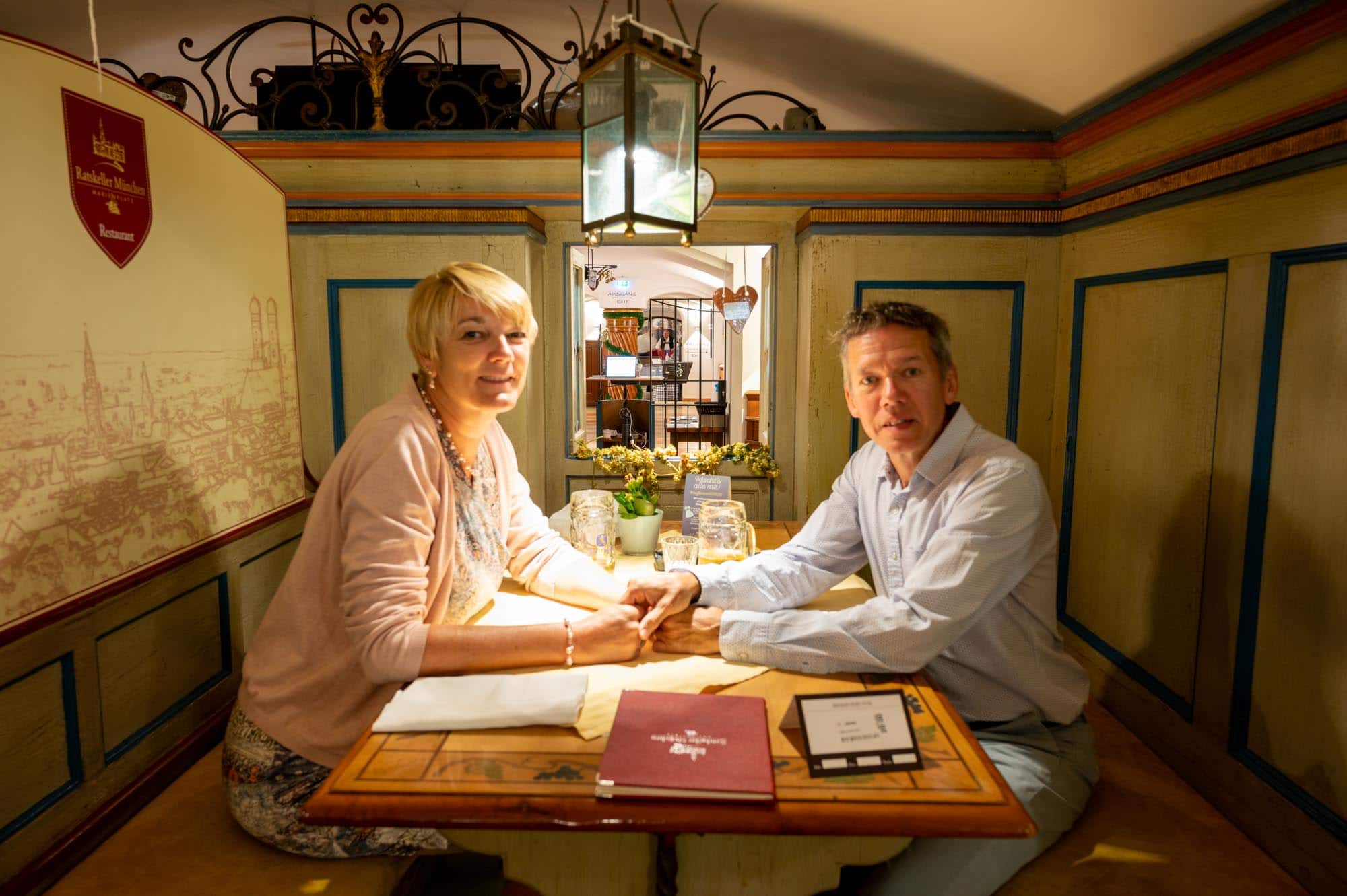



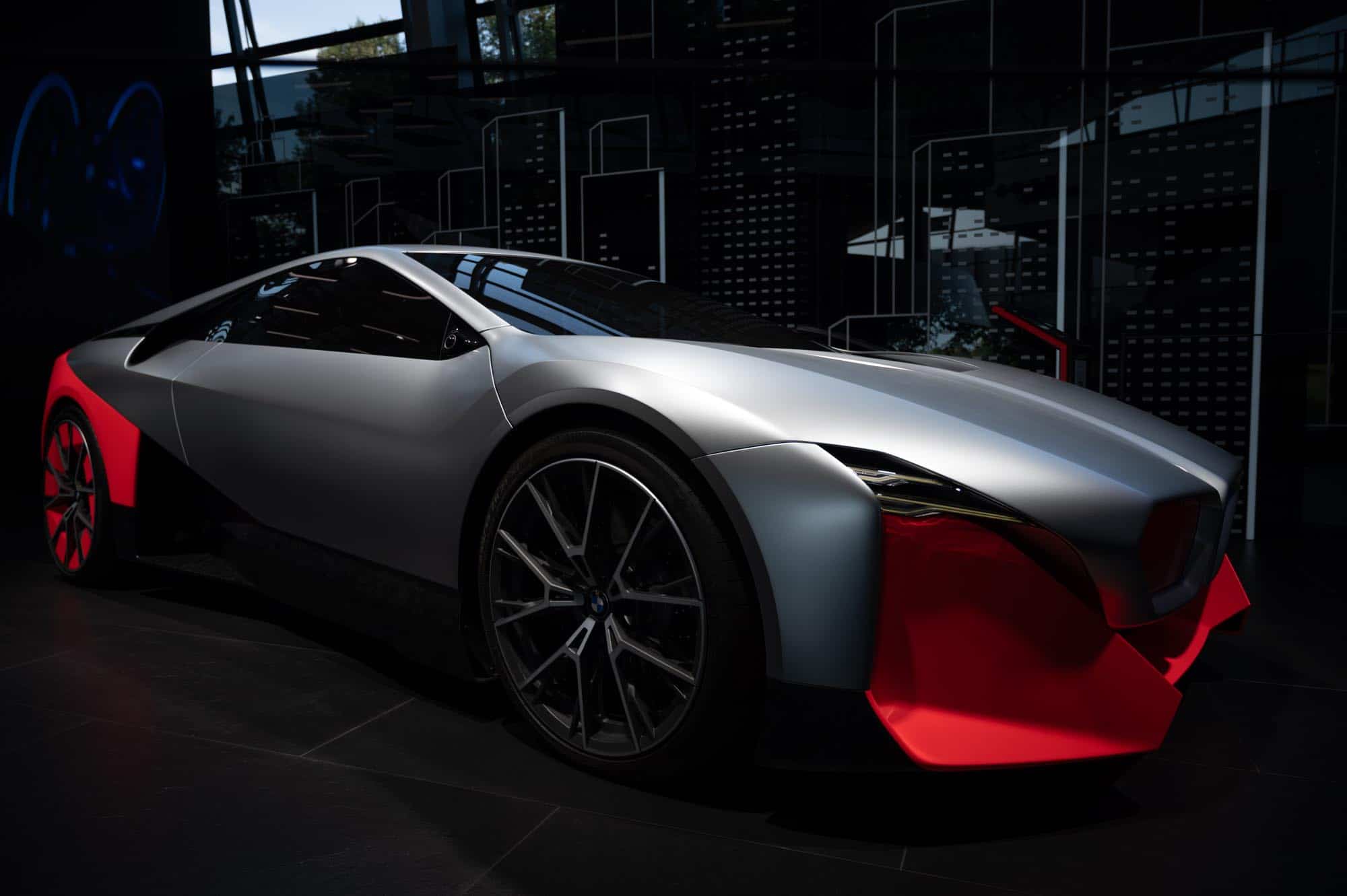

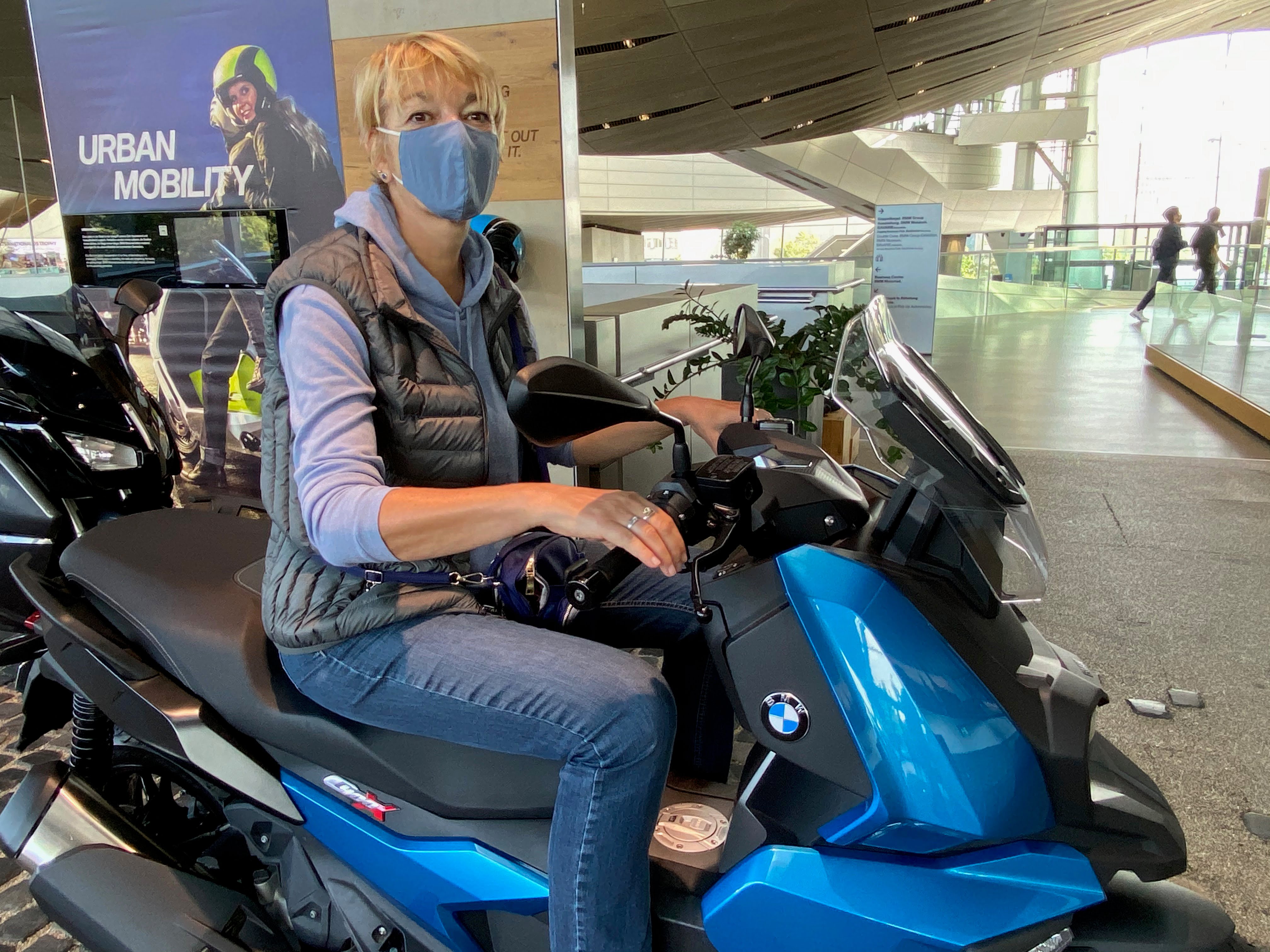
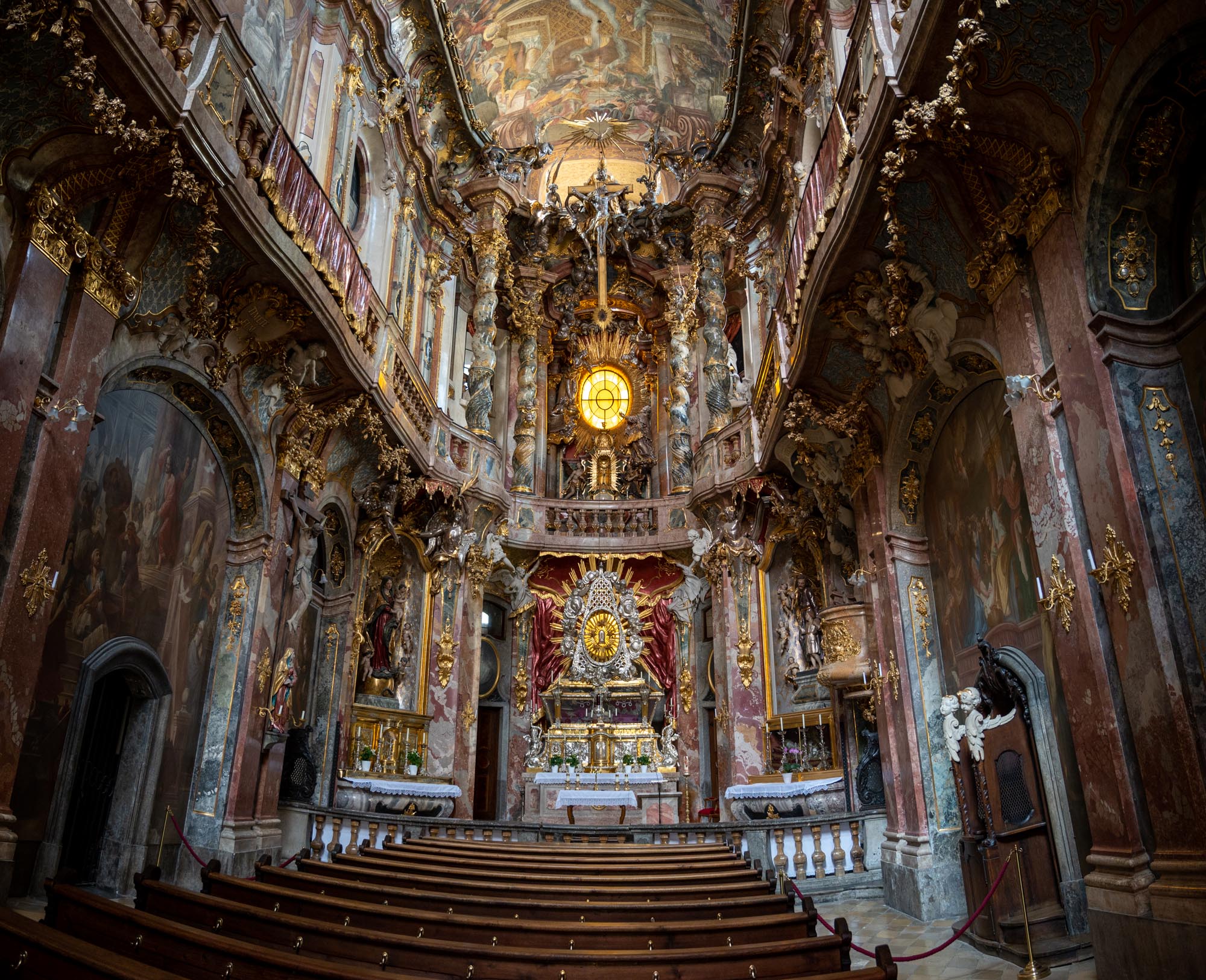

Leave a Reply